 Wonder Woman #36 — Writer: Meredith Finch; Pencils: David Finch; Inks: Richard Friend; Colors: Sonia Oback
Wonder Woman #36 — Writer: Meredith Finch; Pencils: David Finch; Inks: Richard Friend; Colors: Sonia Oback
Sensation Comics Featuring Wonder Woman #4 — (First Story) Creator: Gilbert Hernandez; Colors: John Rauch; (Second Story) Writer: Rob Williams; Art: Tom Lyle; Colors: Wendy Broome; (Third Story) Writer: Nick Kleid; Art: Dean Haspiel; Colors: Allen Passalaqua
Two Wonder Woman books — the regular comic features the debut of a new husband-and-wife creative team, the Finches. It’s OK, although if you liked the previous version you might not be too thrilled; unlike Azzarello/Chiang’s quirky, angular work, this is decidedly mainstream, and looks a lot like all the other New52 books now (I know David Finch has his fans, and he’s definitely more conventionally super-hero-y than Chiang, but, geeze, there’s a double-page splash of the Justice League where Diana looks like she’s maybe 18 years old, and Superman just looks kind of goofy). To Meredith Finch’s credit, the story doesn’t try to reboot and ignore the previous continuity, but it makes the rookie mistake of thinking it has to immediately tear down its main character (to later build her back up, presumably), so we have Diana, who’s investigating the mysterious deaths of a bunch of people in Thailand, arrive and find Swamp Thing there, and immediately start punching him; later, 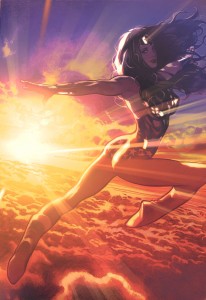 she’s confesses to Aquaman that she’s been feeling overwhelmed, angry and thoughtless. When the story ends with the “death” of a supporting-cast character (who’s died a number of times before), it all seems a little too dark to leave me optimistic about this book’s prospects.
she’s confesses to Aquaman that she’s been feeling overwhelmed, angry and thoughtless. When the story ends with the “death” of a supporting-cast character (who’s died a number of times before), it all seems a little too dark to leave me optimistic about this book’s prospects.
On the other hand, if you want bright, quirky Wonder Woman stories, look no further than Sensation, which offers as a lead-off the last 14 pages of the Gilbert Hernandez story begun in the previous issue, a candy-colored, Silver Age-ish bit of fun that guest-stars both Supergirl and Mary Marvel (if you think some of it looks careless or silly, look again, and then look a third time; Hernendez has an Alex Toth-like knack for reducing an image to its essential, primordial line. The middle tale is fairly standard, but the closer offers art by Dean Haspiel, and any book that offers both Hernandez’s and Haspiel’s takes on the Avenging Amazon is just fine by me.
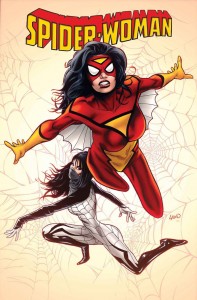 Spider-Woman #1 — Writer: Dennis Hopeless; Pencils: Greg Land; Inks: Jay Leisten; Colors: Frank D’Armata
Spider-Woman #1 — Writer: Dennis Hopeless; Pencils: Greg Land; Inks: Jay Leisten; Colors: Frank D’Armata
Amazing Spider-Man #10 — Writer: Dan Slott; Pencils: Olivier Coipel; Inks: Wade von Grawbadger; Colors: Justoin Ponsor
Another reboot of a female character, this one by Marvel. Here, they tie it into the current “Spider-verse” crossover, with Jessica and the ’30s pulp version of Spider-Man trying to protect Silk, who’s apparently important to the big bad guys who’ve been killing multidimensional Spideys and driving the plot; eventually, they’re joined by the Gwen Stacy and Anya versions, and everything ends on a cliffhanger. OK, and everybody following all the Spider-titles already should have no problem with this, but this seems like a weird choice for a first-issue relaunch of a  character; I mean, isn’t the idea to attract new readers? And wouldn’t they be totally confused by all of this? Spider-Woman gets some things to do here, but in all the chaos and unfamiliar characters there’s little attempt to explain who she is, what she can do or why curious new readers should stick around. Amazing itself is the same roller-coaster ride as always, with dozens of alternate-universe versions of Peter and friends ricocheting around and trying to outhink and outfight their larger-than-life, cosmic-vampire adversaries. In this issue (which occurs right before Spider-Woman #1), “our” Spidey meets up with his Doc Ock-possessed, time-displaced past self, and a little more of the mystery surrounding the bad guys gets explained. Like Axis, it’s a lot of characters doing a lot of fairly-interesting things, and reasonably fun for fans of the Marvel universe.
character; I mean, isn’t the idea to attract new readers? And wouldn’t they be totally confused by all of this? Spider-Woman gets some things to do here, but in all the chaos and unfamiliar characters there’s little attempt to explain who she is, what she can do or why curious new readers should stick around. Amazing itself is the same roller-coaster ride as always, with dozens of alternate-universe versions of Peter and friends ricocheting around and trying to outhink and outfight their larger-than-life, cosmic-vampire adversaries. In this issue (which occurs right before Spider-Woman #1), “our” Spidey meets up with his Doc Ock-possessed, time-displaced past self, and a little more of the mystery surrounding the bad guys gets explained. Like Axis, it’s a lot of characters doing a lot of fairly-interesting things, and reasonably fun for fans of the Marvel universe.
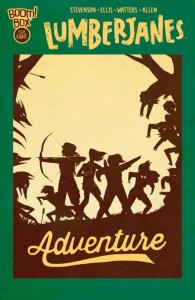 Lumberjanes #8 — Writers: Noelle Stevenson and Grace Ellis; Art: Brooke Allen; Colors: Maarta Latho
Lumberjanes #8 — Writers: Noelle Stevenson and Grace Ellis; Art: Brooke Allen; Colors: Maarta Latho
This issue ends the first arc of the series, and it turns out to offer the best lesson for dealing with female characters: just deliver a well-told story, where everything fits together neatly, everyone gets what they deserve, and there’s plenty of action and adventure; not bad for a weird-looking little book about a band of sort-of-Girl-Scouts at an increasingly-mysterious summer camp. If you’ve been following this, you won’t want to miss it; if not, tough luck, because the early issues are long gone — but wait for the inevitable collection, and in the meantime pick up the next issue of this smart, charming and exciting all-ages comic, so you can get in one the ground floor of the next episode.
 Intersect #1 — Creator: Raw Fawkes
Intersect #1 — Creator: Raw Fawkes
This… is one weird comic; it’s in a dream-like, painterly style, and it’s about a couple of characters running through an almost-deserted city who are experiencing some kind of dimensional or psychological apocalypse; there are two or more people in each body, arguing and merging together, and regular real-life things like household pets have become nightmarish, and insects are somehow involved…. Not a lot is revealed otherwise in this issue, but it’s strangely compelling, and Fawkes offers a Matt Kindt Mind MGMT bit where he includes lots of clues and supplemental material in the margins and endnotes: codes, hints, etc. Like Mind MGMT, it has interesting, unique art, and in between all the puzzles and crazy stuff there’s the outline of what eventually might be a pretty good story; I’ll definitely come back for the second issue.
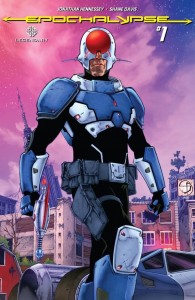 Epochalypse #1 — Writer: Jonathan Hennessey; Pencils: Shane Davis; Colors: Morry Hollowell
Epochalypse #1 — Writer: Jonathan Hennessey; Pencils: Shane Davis; Colors: Morry Hollowell
Another post-apocalypse book (as the title suggests); this one looks at a world where some kind of “incongruity” shifted everyone around in time, so we have a 1930s America, but with citizens from various other time periods, plus a black market in futuristic weapons, microwave ovens, etc., and a police force (who look like Mega-City One judges, but are considerably nicer) trying to track down the anachronisms and get things back to normal. Not a bad setup, and, as with Intersect, there’s enough here to want to keep reading and see what happens next.
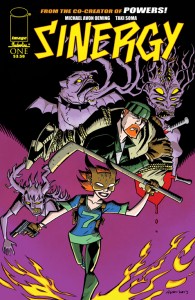 Sinergy #1 — Writers: Michael Avon Oeming and Taki Soma; Art: Michael Avon Oeming; Colors: Taki Soma
Sinergy #1 — Writers: Michael Avon Oeming and Taki Soma; Art: Michael Avon Oeming; Colors: Taki Soma
This new series from Oeming, in the cartoony-but-dramatic style that fans of Powers are familiar with, is about monsters from other dimensions who pass for human, and battle “seers” who can tell what they really are; the daughter of one of these monster hunters discovers all of this after she loses her virginity and is suddenly able to “see” the monsters too — including her boyfriend. Now, she needs to learn how to enter the family business… it’s OK, although Oeming, like a lot of good artists, isn’t quite as good a writer — the girl is more clueless than she needs to be, the plot is cobbled together from bits and pieces of many other sources, and events move a little too slowly, so that by the end of the first issue readers are vaguely disappointed that the real action won’t start until the next issue.
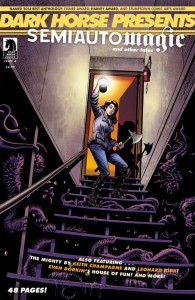 Dark Horse Presents #4 — Creators: Various
Dark Horse Presents #4 — Creators: Various
The cover story for this anthology, “Semiautomagic,” is about an occult investigator, and is by Alex de Campi and longtime pro Jerry Ordway; that’s followed by a typically-psychedelic chapter of Brandan McCarthy’s “Dream Gang,” an offering by the trio of Jimmy Palmiotti, Justin Grey and Andy Kuhn, and another one by Tyler Jenkins. There’s also the start of a new serial, “The Mighty,” by Keith Champagne and Leonard Kirk, and (my favorite) eight pages of “House of Fun” comic strips from the always-cynical, always-darkly-funny Evan Dorkin. That’s a lot of options for $4.99, and odds are at least one of them will be worth the reader’s while.
 Multiversity: Pax Americana #1 (of 1) — Writer: Grant Morrison; Art: Frank Quitely; Colors: Nathan Fairbairn
Multiversity: Pax Americana #1 (of 1) — Writer: Grant Morrison; Art: Frank Quitely; Colors: Nathan Fairbairn
Annihilator #3 — Writer: Grant Morrison; Art/Colors: Frazer Irving
Two by Morrison; Pax Americana continues his Multiversity series, this time looking at the DC world where all the old Charleton heroes live. With old partner Frank Quitely on the art, this is a very good-looking, very densely-written book. You know how some comics, you can just flip through in five minutes, and be done with? Not this one; it uses Captain Atom to meditate on ultimate power, and looks at how that kind of power would corrupt the government around it, too. Figuring out everything going on will take multiple readings — 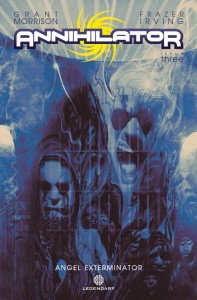 but, then, Morrison is a skillful story architect, so it pays off, and the art is so pretty and precise that those extra passes are a pleasure, not a chore. Annihilator is almost as packed with concepts (and Irving’s art, while in a much shadowier and more expressive style than Quitely’s, is just as up to the task of illustrating it), with lots of meta-commentary on storytelling, as it follows a Hollywood writer diagnosed with an inoperable brain tumor. He’s writing one last script, a science-fiction epic about a cosmic anti-hero, but then the character actually shows up at his house… is it the tumor causing hallucinations? Is there something even weirder going on? Knowing Morrison, of course it’s the latter, and the bickering interplay between the dying writer and the more-conflicted-than-he-seems homicidal space artist slowly turns this into a fascinating and off-kilter buddie movie.
but, then, Morrison is a skillful story architect, so it pays off, and the art is so pretty and precise that those extra passes are a pleasure, not a chore. Annihilator is almost as packed with concepts (and Irving’s art, while in a much shadowier and more expressive style than Quitely’s, is just as up to the task of illustrating it), with lots of meta-commentary on storytelling, as it follows a Hollywood writer diagnosed with an inoperable brain tumor. He’s writing one last script, a science-fiction epic about a cosmic anti-hero, but then the character actually shows up at his house… is it the tumor causing hallucinations? Is there something even weirder going on? Knowing Morrison, of course it’s the latter, and the bickering interplay between the dying writer and the more-conflicted-than-he-seems homicidal space artist slowly turns this into a fascinating and off-kilter buddie movie.
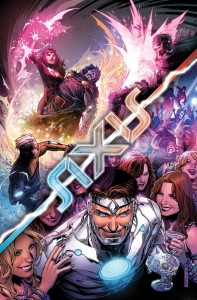 Axis #6 (of 9) — Writer: Rick Remender; Pencils: Terry Dodson; Inks: Rachel Dodson; Colors: Edgar Delgado and Jesus Aburtov
Axis #6 (of 9) — Writer: Rick Remender; Pencils: Terry Dodson; Inks: Rachel Dodson; Colors: Edgar Delgado and Jesus Aburtov
New Avengers #26 — Writer: Jonathan Hickman; Art: Kev Walker; Ink Assist: Scott Hanna; Colors: Frank Martin 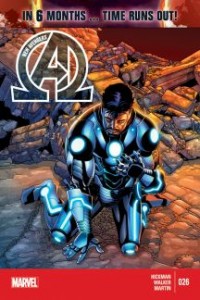 and Dono Sanchez Almara
and Dono Sanchez Almara
Avengers #38 — Writer: Jonathan Hickman; Art: Stefano Caselli; Colors: Frank Martin
Lots of Avengers-related titles (and X-Men, too, in the case of Axis). That crossover series continues the implications of the good guys turning bad (and vice versa), as the X-Men and Apocalypse now rule New York City, and are preparing to set off a gene-bomb that will kill everyone but mutants. Meanwhile, good  Dr Doom fights bad Scarlet Witch, good Loki tries to talk some sense into bad Thor, and Magneto pulls together a ragtag team of former villains to save the day. None of this carries over to the regular Avengers books, though, because they’re in the middle of their own sprawling story by Hickman, one that sees a captured Tony Stark get not-quite-rescued in New Avengers, while over in Avengers pieces of the vast plot start to click into place. Since the covers of the books say “in 6 Months… Time Runs Out” there’s still apparently a ways to go — not that anyone who’s already devoted two and a half years to the story isn’t going to stick around for the payoff….
Dr Doom fights bad Scarlet Witch, good Loki tries to talk some sense into bad Thor, and Magneto pulls together a ragtag team of former villains to save the day. None of this carries over to the regular Avengers books, though, because they’re in the middle of their own sprawling story by Hickman, one that sees a captured Tony Stark get not-quite-rescued in New Avengers, while over in Avengers pieces of the vast plot start to click into place. Since the covers of the books say “in 6 Months… Time Runs Out” there’s still apparently a ways to go — not that anyone who’s already devoted two and a half years to the story isn’t going to stick around for the payoff….
 Daredevil #10 — Writer: Mark Waid; Art: Chris Samnee; Colors: Matthew Wilson
Daredevil #10 — Writer: Mark Waid; Art: Chris Samnee; Colors: Matthew Wilson
Uncanny X-Men #28 — Writer: Brian Michael Bendis; Art: Chris Anka
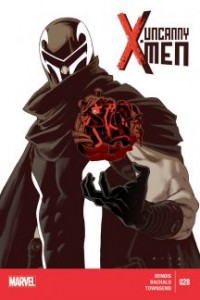 Loki, Agent of Axis #8 — Writer: Al Ewing; Art: Lee Garbett; Colors: Nolan Woodard
Loki, Agent of Axis #8 — Writer: Al Ewing; Art: Lee Garbett; Colors: Nolan Woodard
Guardians of the Galaxy #21 — Writer: Brian Michael Bendis; Art: Valerio Schiti; Colors: Jason Keith
 The rest of this week’s better Marvel books: The Waid/Samnee team on Daredevil finishes up a story about the super-persuasive and casually sociopathic Purple Man and his many similarly-powered children, with the usual crisp art and smart dialogue, and a good personal-life bit for Matt at the end. Uncanny X-Men’s cover has a Bachalo art credit, but the inside is actually by Chris Anka. That’s OK, they’re in the middle of an involved story about a nigh-omnipotent teen mutant and how Cyclops is badass enough to confront him, so no readers
The rest of this week’s better Marvel books: The Waid/Samnee team on Daredevil finishes up a story about the super-persuasive and casually sociopathic Purple Man and his many similarly-powered children, with the usual crisp art and smart dialogue, and a good personal-life bit for Matt at the end. Uncanny X-Men’s cover has a Bachalo art credit, but the inside is actually by Chris Anka. That’s OK, they’re in the middle of an involved story about a nigh-omnipotent teen mutant and how Cyclops is badass enough to confront him, so no readers 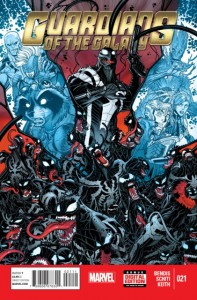 are going to bail at this point. Loki explores the Axis spillover of the more-bad-than-good Enchantress and slightly-more-good-than-bad Loki getting their moral polarities reversed; it turns out that someone who’s bad and trying to be good is better than someone who’s good but decides that makes them better than you. Finally, Guardians , after a few issues of treading water, starts up a new story with, thankfully, the whole diverse and bickering crew back together, leading to a search for Flash Thompson and his alien Venom symbiote that ends on a very satisfying cliffhanger.
are going to bail at this point. Loki explores the Axis spillover of the more-bad-than-good Enchantress and slightly-more-good-than-bad Loki getting their moral polarities reversed; it turns out that someone who’s bad and trying to be good is better than someone who’s good but decides that makes them better than you. Finally, Guardians , after a few issues of treading water, starts up a new story with, thankfully, the whole diverse and bickering crew back together, leading to a search for Flash Thompson and his alien Venom symbiote that ends on a very satisfying cliffhanger.
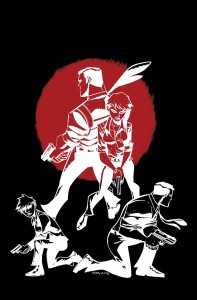 Powers: Bureau #12 — Writer: Brian Michael Bendis; Art: Michael Avon Oeming; Colors: Nick Filardi
Powers: Bureau #12 — Writer: Brian Michael Bendis; Art: Michael Avon Oeming; Colors: Nick Filardi
The conclusion of this iteration of the title, which started with Deena in the FBI and Walker trying to hide cosmic Green Lantern-like powers, and ends with both of them…not, and in the middle of a vast conspiracy. With a TV version of the comic on its way in a few months (on, as the book’s cover proclaims, Sony’s Playstation Network), much of this looks like scraping away years’ worth of accumulated plot barnacles, so the next volume of the title can get back to the same basics — with Walker and Pilgrim on powers-centric gritty police procedurals — that are why this book’s been around for going on 20 years, so it seems like a canny move.
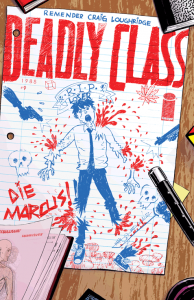 Deadly Class #9 — Writer: Rick Remender; Art: Wes Craig; Colors: Lee Loughridge
Deadly Class #9 — Writer: Rick Remender; Art: Wes Craig; Colors: Lee Loughridge
Romantic and murderous goings-on at a school for teenage assassins, scions of many shadowy, rich and amoral global crime families. Worth a look, especially for Craig’s figure and emotional work, and Remender’s sharp, empathetic approach to character.
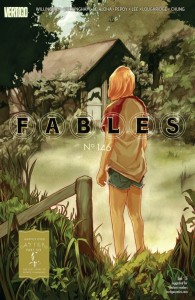 Fables #146 — Writer: Bill Willingham; Pencils: Mark Buckingham; Inks: Steve Leialoha and Andrew Pepoy; Colors: Lee Loughridge
Fables #146 — Writer: Bill Willingham; Pencils: Mark Buckingham; Inks: Steve Leialoha and Andrew Pepoy; Colors: Lee Loughridge
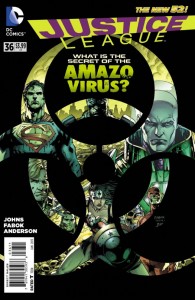 Justice League #36 — Writer: Geoff Johns; Art: Jason Fabok; Colors: Brad Anderson
Justice League #36 — Writer: Geoff Johns; Art: Jason Fabok; Colors: Brad Anderson
Astro City #17 — Writer: Kurt Busiek; Pencils/Layouts: Tom Grummett; Finishes: Diverse Hands; Colors: Wendy Broome
Concluding with a trio of DC titles; Justice League is their 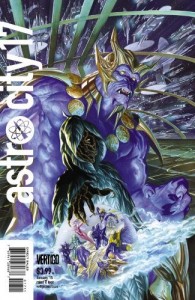 big mainstream hit, and offers the trinity of Superman, Batman and Wonder Woman, battling a quick-spreading virus accidentally released from the lab of now-fellow-Leaguer Lex Luthor that grants its victims a few hours of super powers before burning them out and killing them. Fables and Astro City are both long-running cult indy series on the Vertigo imprint; Fables is rounding into its final issue, #150, with a Camelot rift that should settle most of the characters’ fates permanently, while Astro City uses a fill-in artist to tell a typically-well-crafted one-issue story about sacrifice and memorial, one that wouldn’t have been out of place on Veteran’s Day.
big mainstream hit, and offers the trinity of Superman, Batman and Wonder Woman, battling a quick-spreading virus accidentally released from the lab of now-fellow-Leaguer Lex Luthor that grants its victims a few hours of super powers before burning them out and killing them. Fables and Astro City are both long-running cult indy series on the Vertigo imprint; Fables is rounding into its final issue, #150, with a Camelot rift that should settle most of the characters’ fates permanently, while Astro City uses a fill-in artist to tell a typically-well-crafted one-issue story about sacrifice and memorial, one that wouldn’t have been out of place on Veteran’s Day.



